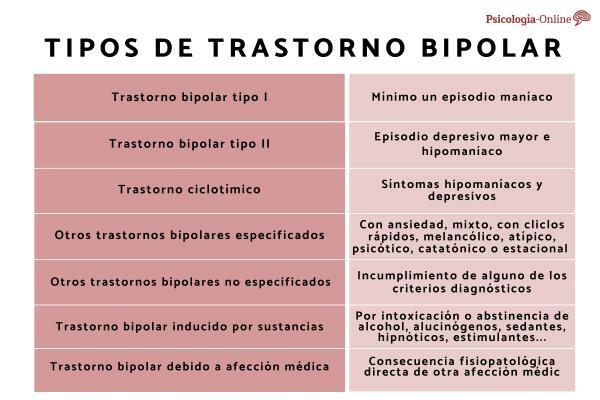
Mood-related problems can appear in the population by excess or by default, this It is either due to the presence of a low state of mind or due to the experience of a high state of mind.
While it is true that our mood can fluctuate based on numerous circumstances (even throughout the day), this fluctuation is often within normality. Sometimes these fluctuations can be much more exaggerated and even interfere with life daily life of the patient and cause discomfort to those who suffer from it, and this is what happens in disorders bipolar. If you want to know more, continue reading this Psychology-Online article in which we expose the types of bipolarity and their symptoms.
Index
- Episodes of bipolar disorders and their symptoms
- The classification of bipolar disorders
- Type I bipolar disorder
- Type II bipolar disorder
- Cyclothymia
- Type III bipolar disorder
- Fast cycling
Episodes of bipolar disorders and their symptoms.
Bipolar disorders are mood disorders
Major depressive episode
A major depressive episode lasts at least two weeks. During this time, following the diagnostic classification DSM-5 (American Psychiatric Association[1]) the following symptoms may appear.
- Experiencing depressed mood.
- Lack of pleasure and / or interest in all or almost all activities.
- Increase or decrease in body weight and / or loss of appetite.
- Insomnia or hypersomnia.
- Psychomotor agitation or retardation.
- Fatigue or loss of energy.
- Feeling of excessive guilt and / or worthlessness.
- Decreased ability to concentrate and / or make decisions.
- Recurring suicidal thoughts and / or thoughts of death.
Hypomanic episode
If in the major depressive episode the mood is abnormally low, in this episode and in the manic episode it is abnormally high, expansive or irritable. The person is energetic and his activity increases. The duration in this case is less than for the major depressive episode, since they are only necessary four days in a row.
The symptoms proposed by the DSM-5 classification for the hypomanic episode are the following:
- Increased self-esteem or feeling of greatness.
- Disminution of necesity of sleep.
- He is more talkative than usual.
- Presents flight of ideas or, where appropriate, subjective experience that your thoughts are racing.
- Easily distracted.
- Psychomotor agitation or increased activity directed towards a goal.
- He participates excessively in activities that can have negative consequences (such as compulsive shopping, risky sexual behaviors, etc.).
In the following article, you can see more about the hypomania.
Manic episode
As we indicated previously, in this episode the mood is also abnormally high. In this case, the episode must be present at least one week. The episode, unlike the hypomanic episode, is serious enough to cause an alteration in social or work functioning or even require hospitalization.
Finally, if the episode presents psychotic characteristics, hypomania will be ruled out and it will be considered, directly, manic.
The classification of bipolar disorders.
How many types of bipolarity are there? Bipolar disorders are included in the DSM-5 and ICD-11 classifications (World Health Organization [2]). In both classifications we find five types:
- Type I bipolar disorder.
- Type II bipolar disorder.
- Cyclothymic disorder
- Other specified bipolar disorders or related disorders.
- Other unspecified bipolar disorders or related disorders.
- Bipolar Disorder and Related Substance / Medication-Induced Disorder.
- Bipolar Disorder and Related Disorder Due to Another Medical Condition.
The first three are discussed later.
In the following two, those patients who present symptoms of the bipolar picture but who, for some reason (which the professional may or may not specify), they do not meet all the criteria for their diagnosis.
In the case of DSM-5, two other categories are added: substance-induced bipolar disorder and bipolar disorder due to another medical condition. depending on whether the symptoms are caused by the consumption of any substance or medication or if the affectation is caused by some disease.
Type I bipolar disorder.
Type I bipolar disorder is characterized by the appearance of a manic episode and, before or after this, there may have been both hypomanic episodes and episodes of major depression.
This type of disorder, in turn, is classified according to the current or most recent episode that has appeared:
- Most recent hypomanic episode.
- Most recent episode manic.
- Most recent depressive episode.
- Most recent unspecified episode (when criteria are met for any of the above except duration).
Type II bipolar disorder.
For the diagnosis of this type of bipolarity, there must be a history of one or more major depressive episodes and presence or history of a hypomanic episode. Manic episodes do not appear in this type of bipolar disorder. In the same way as in type I bipolar disorder, the most recent episode can be specified: hypomanic or major depressive in this case.
Cyclothymia.
Cyclothymic disorder works in a similar way to bipolar disorder, with episodes of abnormally high and abnormally low mood. In this case, they appear hypomanic and depressive symptoms but they do not meet the criteria for the episode. Symptoms are present two yearsat least half the time and they have not been absent for more than two months in a row. Symptoms cause clinically significant distress or impairment in social, occupational, or other areas of functioning.
In this article, you will find more information about cyclothymia.
Type III bipolar disorder.
Regardless of the disorders proposed in the diagnostic classifications, there seems to be some consensus regarding the existence of a third type of bipolar disorder. Type III bipolar disorder would encompass the patients with a family history of bipolar disorder and present hypomania and / or depression only during treatment with antidepressants (González Parra, D. et al, 2007 [3]), therefore, the episodes would be caused by the drugs themselves.
Rapid cycling.
Along with the diagnosis, a "fast cycles" specifier when in the last twelve months at least four mood episodes have appeared, spaced two months apart as minimal or with a change of polarity, of those previously exposed: major depressive episode, hypomanic episode and episode maniac.
This article is merely informative, in Psychology-Online we do not have the power to make a diagnosis or recommend a treatment. We invite you to go to a psychologist to treat your particular case.
If you want to read more articles similar to Types of bipolarity: symptoms, causes and duration, we recommend that you enter our category of Clinical psychology.
References
- American Psychiatric Association (2014). DSM-5. Reference guide to the diagnostic criteria of the DSM-5-Breviary. Madrid: Editorial Médica Panamericana.
- World Health Organization (WHO) (2018) International Classification of Diseases, 11th revision. Recovered from https://icd.who.int/es
- González Parra, D., González de María, V., Leal Sánchez, C., Sánchez Iglesias, S. (2007) Bipolar illness. Medicine, 9 (85) 5461-5468
Bibliography
- Sevillá, J., Pastor, C. and Ruiz, L. (2014). Bipolar disorder and related disorders. In Caballo, V.E., Salazar, I.C. And Carrobles, J.A. (2014) Manual of Psychopathology and Psychological Disorders. Madrid. Pyramid.


